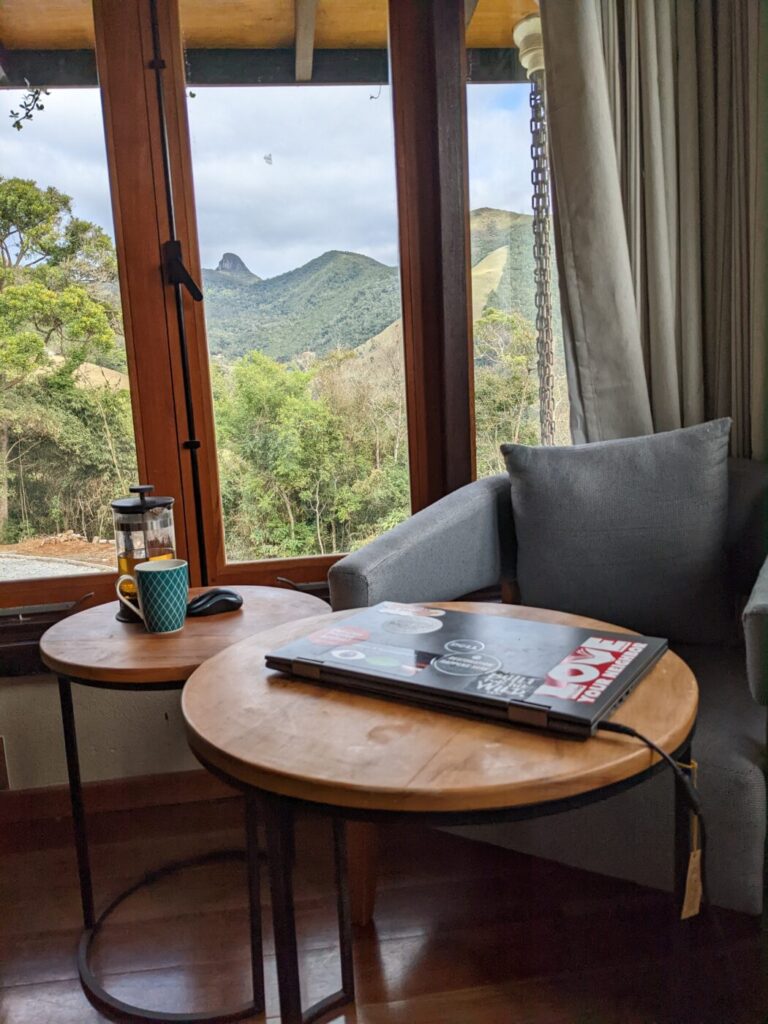More Sustainable Doesn’t Have to Equal Less Comfort
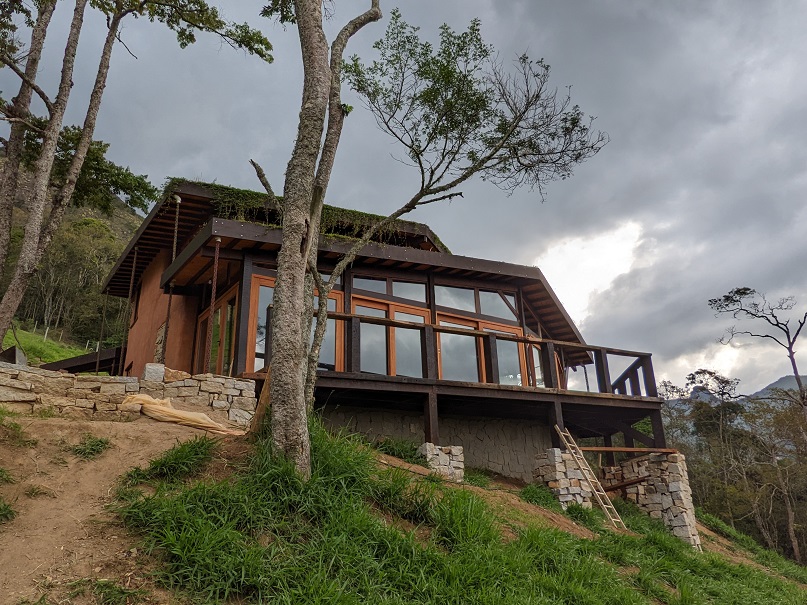
We are the first guests to stay in Eco Caminhos’ newly-built Eco Lodge, a gorgeous natural building in the mountains north of Rio de Janeiro. Liuan originally wrote this post about our experiences for the Eco Caminhos website.
“If you want to be nice to the environment, go ahead and build a shack in the woods, dance half-naked around the fire, and cut yourself off from the system.” This is the essence of what Matt told me in one of our many discussions around my environmental ideals and modern reality.
In my ideal world, I want to have a positive rather than negative impact on the earth. But the reality is that we live in a global society structured around high energy consumption, disrespect for nature, and depletion of natural resources. It’s hard, on your own, to escape living in this system.
Given this reality, the idea of sustainable living has often been tied to the idea of sacrifice. To be kind to the planet, we think, we must sacrifice our conveniences, our meat, our flights, and our creaturely comforts like a warm house in the winter. We assume that reducing our carbon and ecological footprint means we have to go backwards along the trajectory of human progress. We have to regress to a more primitive, less comfortable, way of life.
I still think we need to dramatically shift our understanding of a “good life” toward less materialism and consumption. But living at the Eco Lodge here at Eco Caminhos has made me question the equation of MORE SUSTAINABLE = LESS COMFORT.
What is Eco Caminhos and the Eco Lodge?
Eco Caminhos is a permaculture farm in the mountains north of Rio de Janeiro, within the Atlantic Forest ecosystem. Their focus is on bioconstruction (using sustainable, local, and natural materials to build) and agroforestry (integrating trees and mimicking forest systems in crop growing). They also welcome a range of people to participate and learn, including local Brazilian apprentices, short- and long-term international volunteers, and families like us.
The Eco Lodge is the third major natural building that Bart Bijen (the founder of Eco Caminhos) and his team have taken on. When you enter the gates of the farm, located on outskirts of Nova Friburgo city, you can see the Eco Lodge perched at the top of a steep, zigzagging road into the property. It is a beautiful structure – rustic wooden outlines, stone base, earth-toned walls, vines from the green roof hanging down, and an expansive glass-lined living area opening out to a recycled-wood deck that takes in the sweep of the mountains and the Cardinot valley.
Since we started traveling South America three months ago, the Eco Lodge is by far the most luxurious accommodation we’ve stayed in. It is also, amazingly, the most sustainable. The building is made almost entirely of sustainable materials: locally sourced rocks, recycled wood, and cob walls consisting of a mixture of clay, sand, grass, and manure (almost all found on the property). There were some elements that had to be obtained from farther away, for example, hardwood beams (which are certified as not coming from the Amazon rainforest), various fixtures, drywall for the upstairs room partitions, and wood finishes.
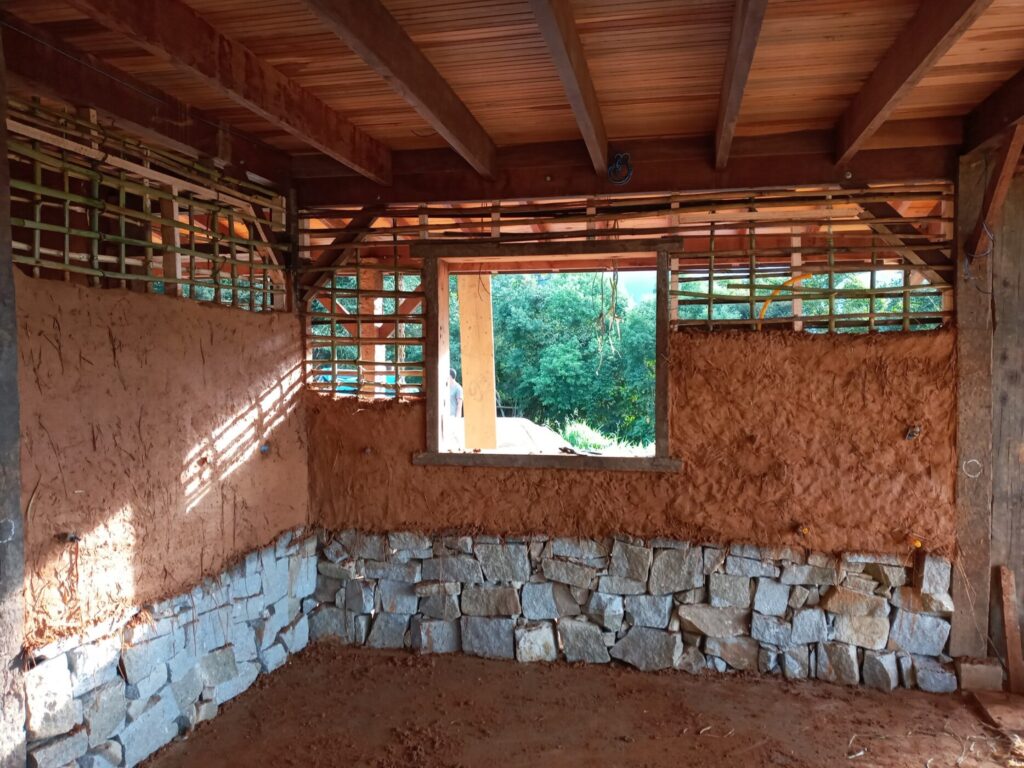
Connected to the farm’s solar net zero energy system, all the electricity we use in the Eco Lodge is renewable and carbon-free. The induction stove is electric and the hot water is powered by a solar boiler, so the building uses no natural gas. Our water supply is filtered after coming from higher-elevation mountain springs, and our waste water goes into a black-water and grey-water banana filter system directly below the house.
How does it feel to stay in the Eco Lodge?
Warmer
We stayed in a condo not far from Eco Caminhos for the first month of our time in Brazil, during July and August. Though this was an upper-class neighborhood, the home was built in typical Brazilian style—concrete walls, tile roof, and drafty. (Concrete, though cheap and convenient, has a huge carbon footprint.) Winters in this area are mild by Midwestern US standards, with temperatures dipping into the 40s Fahrenheit, or about 5 degrees Celsius. But without indoor heating or insulation, this translates to considerable discomfort. On some of the coldest days we wrapped ourselves in blankets, put on dance music, and did everything we could to keep warm.
The Eco Lodge, with its thick earthen walls, holds heat in the winter and keeps cool in the summer. Despite some rainy, chilly days here, we haven’t felt nearly as cold as we did in the other Brazilian houses we’ve stayed in. Our kids have also really enjoyed tending the wood-burning fireplace, which is equipped with a fan that distributes the heat throughout the house.
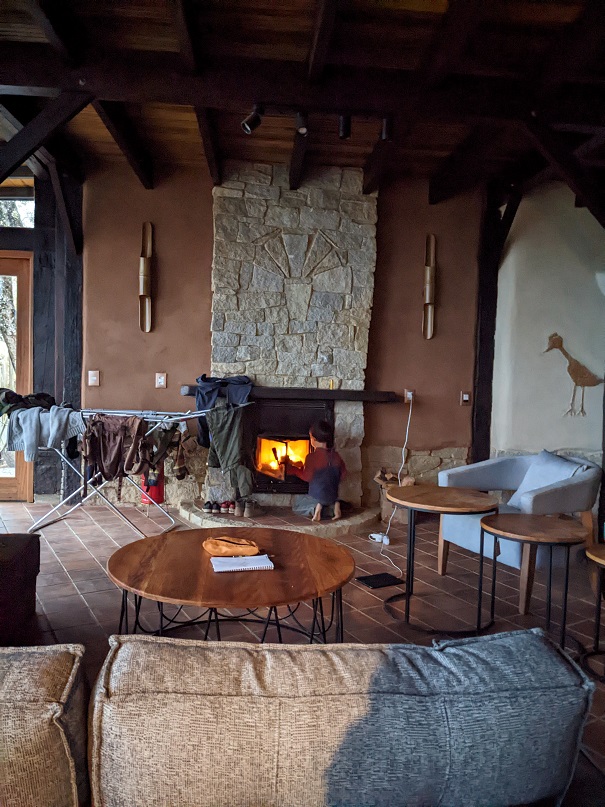
As the world adjusts to more extreme weather, we can take inspiration from houses like these. The Eco Lodge is built with attention to the local microclimate, such as the position of the sun, the shadows of the mountains, how the water flows downhill, and wind patterns. Taking cues from nature, the goal is to work with, rather than against, the elements. By building smartly and consciously, we can preserve human comfort without further damaging the ecosystems that support us.
Small adjustments to rely on renewable energy
Solar energy is just that—coming from the sun. The farm produces solar energy through 16 panels installed on the roof of an all-purpose pavilion and uses solar boilers for heating water. But on days when it’s not sunny, these panels are not producing enough for everyday use. The available battery storage technology is still too expensive and ineffective to warrant the investment. While the goal is to become totally energy-independent, for now the farm is connected to the larger electricity grid. It puts solar energy into the grid when there is excess and relies on the grid when more is needed. This amounts to a net-zero energy balance.
For the solar water boiler, most of the time the hot water tank is not connected to the grid. There is often enough sun during the day to sufficiently heat the tank for warm showers. But if it’s a cloudy day and we want to shower, we have to remember to switch on the breaker for the water boiler to connect it to the grid and let it warm for a few hours. Otherwise, it’s a VERY refreshing cold shower. We’ve preferred to stay dirty on days when we forget.

This is an example of the kinds of small changes we will need to make as we shift our energy systems away from fossil fuels to wind and solar energy. Like the people of Uruguay, who are leading the way in an energy transition that doesn’t sacrifice human comfort, we might have to organize our more energy-intensive tasks around the periods when wind and sun are most abundant. For me, these small shifts are totally worth the benefits of not releasing more carbon into the atmosphere and further polluting the air we breathe.
Connected to the Earth
We wake up at six in the morning to daylight breaking through the curtains and bird calls. I rub my eyes, put my feet on the acacia wood floor, and pull aside the curtains to see what views Mother Nature is gifting today. Sometimes it’s a lush world of drizzly mist, sometimes it’s bright sunshine and a breeze, sometimes it’s fluffy clouds that blanket the valley below. Often, I open the windows to look out over the green roof and take a couple minutes to breathe the crisp mountain air.
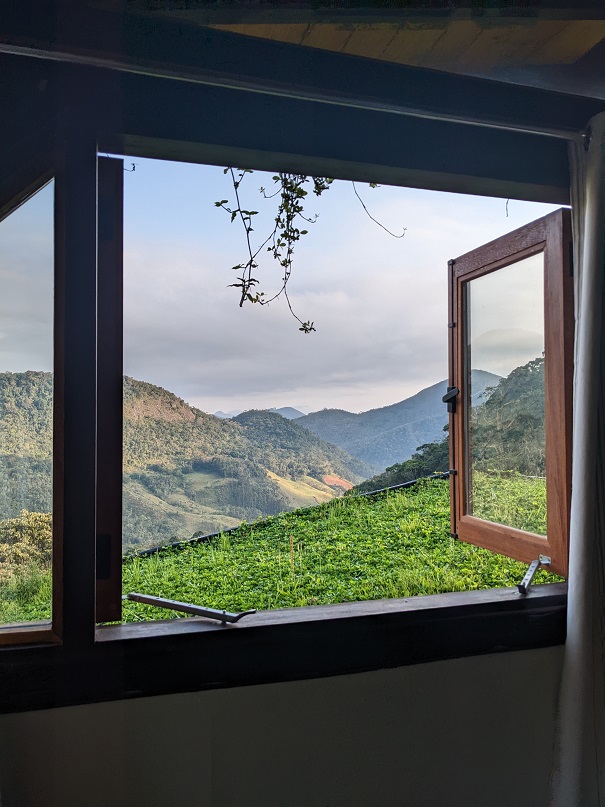
After getting dressed for a day of work on the farm, I walk down the spiral staircase to see my kids playing in front of the wall-to-wall glass windows that open out to the terrace. I never get tired of this stunning view. My toes touch the cool tile and I shuffle over to the open-concept kitchen to eat breakfast.
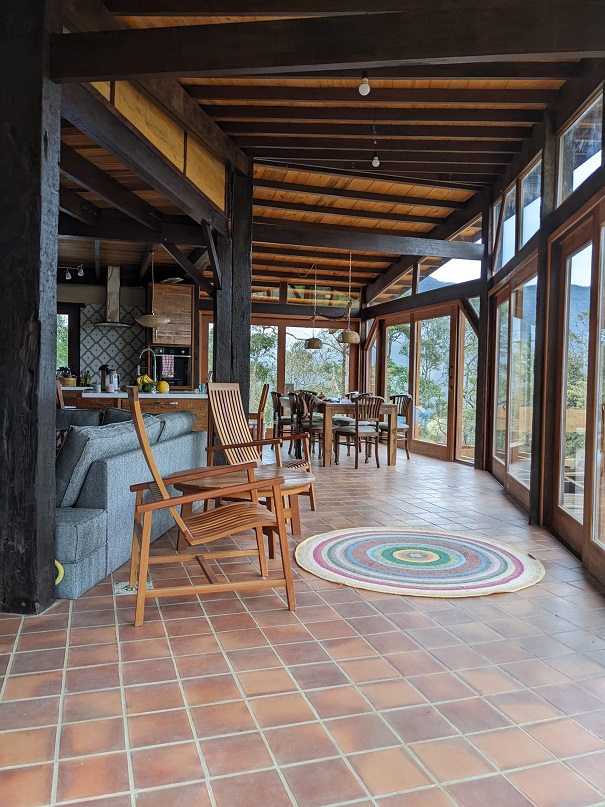
After breakfast, we walk the farm road up to Colmeia, where the day’s farm activities begin. This is one of my favorite parts of the day. We step out right into the middle of the farm, not quite knowing what the day holds. Maybe it will be an encounter with a cow, a good conversation with other volunteers, a reflective time planting corn among the zucchini seedlings, or the satisfying manual labor of collecting cow manure or digging a trench to start a bioconstructed toolshed.
After a full day of work and learning, I often stop by the fields on the way home to pull a head of lettuce and some green onions to make a salad to go with dinner. Maybe we’ll have some roasted cauliflower from the fields as well, or lentils with farm-grown collard greens. It’s lovely to live so close to the food we’re eating and understand the love and respect that has gone into growing it.
As the sun sets, I look over the mountain ridges encircling the Eco Lodge. There’s Focinho do Porco (Pig’s Snout), my favorite, towering over the rest in the distance. It’s a special experience to stay in a place like this, sheltered by the wood, stone, and earth that has formed right in this area over decades and millennia. I know we won’t always be in such a beautiful place, but I hope to recreate this feeling of connection to the earth in whatever places we end up calling home.
